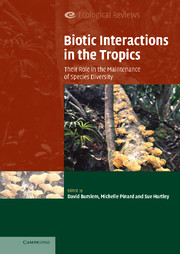Book contents
- Frontmatter
- Contents
- List of contributors
- Preface
- PART I Plant–plant interactions
- PART II Plant–microbe interactions
- PART III Plant–animal interactions
- 10 Implications of plant spatial distribution for pollination and seed production
- 11 Seed dispersal of woody plants in tropical forests: concepts, examples and future directions
- 12 The role of trophic interactions in community initiation, maintenance and degradation
- 13 Impacts of herbivores on tropical plant diversity
- 14 Have the impacts of insect herbivores on the growth of tropical tree seedlings been underestimated?
- 15 Multi-trophic interactions and biodiversity: beetles, ants, caterpillars and plants
- 16 The trophic structure of tropical ant–plant–herbivore interactions: community consequences and coevolutionary dynamics
- 17 Multitrophic interactions in a neotropical savanna: ant–hemipteran systems, associated insect herbivores and a host plant
- PART IV Biotic interactions in human-dominated landscapes
- Index
- References
16 - The trophic structure of tropical ant–plant–herbivore interactions: community consequences and coevolutionary dynamics
Published online by Cambridge University Press: 25 August 2009
- Frontmatter
- Contents
- List of contributors
- Preface
- PART I Plant–plant interactions
- PART II Plant–microbe interactions
- PART III Plant–animal interactions
- 10 Implications of plant spatial distribution for pollination and seed production
- 11 Seed dispersal of woody plants in tropical forests: concepts, examples and future directions
- 12 The role of trophic interactions in community initiation, maintenance and degradation
- 13 Impacts of herbivores on tropical plant diversity
- 14 Have the impacts of insect herbivores on the growth of tropical tree seedlings been underestimated?
- 15 Multi-trophic interactions and biodiversity: beetles, ants, caterpillars and plants
- 16 The trophic structure of tropical ant–plant–herbivore interactions: community consequences and coevolutionary dynamics
- 17 Multitrophic interactions in a neotropical savanna: ant–hemipteran systems, associated insect herbivores and a host plant
- PART IV Biotic interactions in human-dominated landscapes
- Index
- References
Summary
Introduction
The first part of this paper examines the consequences of an interlocking set of mutualisms, involving ants, plants, bacteria and phloem-feeding insects, for the structure and functioning of herbivore-based food webs in tropical communities. This part draws heavily from important recent work by Davidson and colleagues (Davidson 1997; Davidson et al. 2003) and extends their discussion of community-level implications of their findings. The second part explores how trophic interactions evolve when coevolution produces specialized symbiotic ant–plant mutualisms, and is based largely on our own work on interactions between ants and Leonardoxa myrmecophytes of African rainforests. The paper complements a recent general review of ant–plant protection mutualisms (Heil & McKey 2003).
Ant–plant–herbivore interactions and tropical food webs
How food webs function, and how trophic interactions shape communities, have long been central questions in ecology. Interactions between organisms at adjacent trophic levels – predators and prey, parasites and hosts – and competitive interactions among organisms at the same trophic level, all occupy major roles in theories to explain the great species richness and other traits of tropical forest ecosystems (Wright 2002). Following the lead of classic studies like those of Hairston et al. (1960) and Paine (1966), investigations of how communities function have increasingly taken into account not only these direct interactions, but also indirect interactions that extend across several trophic levels. Do natural enemies of herbivores have measurable impacts on fitness of individual plants, on relative abundance of plant species, on primary productivity or on plant species diversity?
- Type
- Chapter
- Information
- Biotic Interactions in the TropicsTheir Role in the Maintenance of Species Diversity, pp. 386 - 413Publisher: Cambridge University PressPrint publication year: 2005
References
- 16
- Cited by



